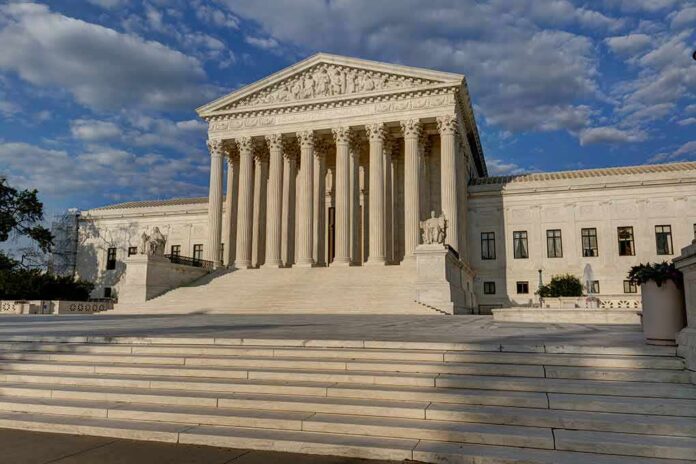The U.S. Supreme Court declines to halt federal regulations aimed at reducing carbon emissions from power plants, marking a significant victory for the Biden administration’s climate strategy.
At a Glance
- Supreme Court allows EPA to proceed with plans to limit carbon emissions from power plants
- The ruling is temporary as challenges progress through lower courts
- Over two dozen states and industry groups challenged the regulation
- The rule requires coal-fired plants to capture 90% of carbon emissions or shut down within eight years
- EPA estimates the rule could provide up to $370 billion in climate and health benefits by 2047
Supreme Court’s Landmark Decision on Carbon Emissions
In a significant development for environmental policy, the U.S. Supreme Court has refused to block a federal regulation designed to reduce carbon emissions from coal- and gas-powered plants. This decision, albeit temporary, represents a crucial victory for President Biden’s climate change strategy and underscores the judiciary’s pivotal role in shaping national climate policy.
The ruling allows the Environmental Protection Agency (EPA) to move forward with its plans to limit carbon emissions from power plants, a key component of the Biden administration’s broader goal to reduce pollution from emissions by 2050. This decision comes despite opposition from over two dozen states and various industry associations, who challenged the regulation’s effectiveness and questioned the EPA’s authority.
🚨 BREAKING: SCOTUS just cleared the way for @POTUS' carbon pollution standards on power plants to go into effect.
The rules are one of the Biden-administration's most consequential climate actions.
This is HUGE!https://t.co/sx3kOOTlbT
— Evergreen Action (@EvergreenAction) October 16, 2024
Implications of the Supreme Court’s Decision
The Supreme Court’s decision is provisional, made in response to an emergency application as the challenge progresses through lower courts. It signals a potential shift in the court’s approach to environmental regulations, considering its conservative majority. Notably, Justice Clarence Thomas dissented, while Justices Brett Kavanaugh and Neil Gorsuch suggested that challengers might succeed on some claims but saw no immediate need to block the rule.
The EPA rule mandates that coal-fired power plants capture 90% of carbon emissions or shut down within eight years, with compliance deadlines starting in 2025. This ambitious target is part of President Biden’s broader goal to eliminate carbon pollution from the electricity sector by 2035 and economy-wide by 2050.
Economic and Environmental Considerations
Critics of the regulation, including the National Mining Association, argue that the EPA has overstepped its authority and imposed unattainable standards. They warn of potential economic harm and increased electricity demand. Conversely, environmental groups like the Natural Resources Defense Council support the rule, calling it modest but essential in the fight against climate change.
The EPA estimates that the rule could provide up to $370 billion in climate and health benefits and prevent 1.4 billion metric tons of carbon pollution by 2047. This substantial reduction in carbon emissions is equivalent to removing 328 million gasoline-powered cars from the roads.
Big Oil tried to stop important climate action, but in a win for the planet, the Biden administration's commonsense restrictions on methane pollution are safe! The Supreme Court rejected bogus arguments and should do so again with the next climate case.https://t.co/7Mvi7elXQT
— NRDC 🌎🏡 (@NRDC) October 4, 2024
Future Challenges and Considerations
While this ruling represents a victory for the Biden administration’s climate agenda, it’s important to note that the battle is far from over. The challengers may return to the Supreme Court for relief after the D.C. Circuit Court’s ruling if necessary. Additionally, a recent ruling overturning the Chevron decision may complicate future environmental regulations.
As the nation grapples with balancing economic interests and ecological responsibilities, this Supreme Court decision marks a critical juncture in the ongoing debate over climate policy. It remains to be seen how this ruling will shape future environmental regulations and the broader landscape of America’s approach to combating climate change.
Sources:
- Supreme Court clears way for Biden’s plan to cut power plant emissions
- Supreme Court Allows E.P.A. to Limit Power Plant Emissions
- Supreme Court allows rule limiting pollution from coal-fired power plants to remain in effect
- Supreme Court allows EPA emissions rule to stand while litigation continues











